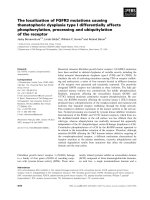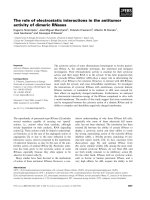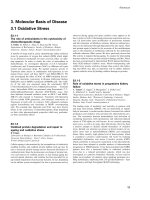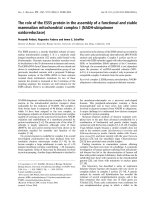Báo cáo khoa học: "The incidence of recurrent flushing and its effect on branch production in Quercus petraea (Matt) Liebl growing in southern England" ppt
Bạn đang xem bản rút gọn của tài liệu. Xem và tải ngay bản đầy đủ của tài liệu tại đây (500.92 KB, 9 trang )
Original
article
The
incidence
of
recurrent
flushing
and
its
effect
on
branch
production
in
Quercus
petraea
(Matt)
Liebl
growing
in
southern
England
R
Harmer
Forestry
Commission,
Alice
Holt
Research
Station,
Wrecclesham,
Farnham,
Surrey
GU10
4LH,
UK
(Received
27
April
1992;
accepted
22
July
1992)
Summary —
The
incidence
of
recurrent
flushing
on
leading
shoots
and
major
branches
of
Quercus
petraea
growing
in
southern
England
was
examined
over
an
8-year
growth
period.
Three
types
of
shoot
section
were
defined:
SPRING -
initial
flushes
produced
in
spring
that
did
not
form
a
2nd
flush;
FIRST -
initial
flushes
produced
in
spring
that
formed
a
2nd
flush;
SECOND -
those
formed
by
recurrent
flushing.
The
proportion
of
shoots
forming
a
SECOND
flush
varied
from
4-100%,
the
leaders
flushing
more
frequently
than
branches.
There
were
differences
between
trees
in
the
ten-
dency
to
recurrent
flushing,
in
general
one
SECOND
flush
was
produced
for
every
1.4
flushes
initial-
ly
produced.
The
SECOND
flush
was
always
longest.
The number
of
branches
produced
by
each
type
of
flush
varied
but
this
was
related,
in
part,
to
differences
in
shoot
length.
The
effect
of
recurrent
flushing
on
branching
and
stem
form
is
discussed.
Quercus petraea
/
recurrent
flushing
/ branching
Résumé —
Fréquence
d’apparition
d’une
croissance
polycyclique
et
son
effet
sur
la
produc-
tion
des
branches
du
Quercus
petraea
(Matt)
Liebl
dans
le
Sud
de
l’Angleterre.
La
fréquence
d’apparition
d’une
croissance
polycyclique
sur
les
pousses
apicales
et
les
branches
principales
du
Quercus
petraea
dans
les
conditions
du
Sud
de
l’Angleterre,
a
été
examinée
sur
une
période
corres-
pondant
à
8
années
de
végétation.
Trois
types
de
pousses
ont
été
définies :
PRINTEMPS -
pre-
mières
pousses
produites
au
printemps
ne
donnant
pas
de
2e
pousse;
PREMIÈRES -
premières
pousses
produites
au
printemps
formant
ensuite
une
2e
pousse;
DEUXIÈME -
pousses
formées
par
croissance
polycyclique.
Le
pourcentage
de
pousses
donnant
une
DEUXIÈME
pousse
variait
entre
4
et
100%,
le
polycyclisme
apparaissant plus
fréquemment
sur
les
pousses
apicales
que
sur
les
branches.
On
a
observé
des
différences
entre
arbres
en
ce
qui
concerne
la
tendance
au
polycy-
clisme.
En
général,
on
a
compté
une
DEUXIÈME
pousse
pour
1,4
pousses
initialement
produite,
cette
DEUXIÈME
pousse
étant
toujours
plus
longue
que
les
pousses
à
l’extrêmité
desquelles
elle
apparaissait.
Chaque
type
de
pousses
a
donné
un
nombre
de
rameaux
variable,
en
partie
fonction
de
la
longueur
de
la
pousse.
L’effet
de
la
croissance
polycylique
sur
la
ramification
et
la
forme
des
tiges
fait
l’objet
d’une
discussion.
Quercus
petraea
/ croissance
polycyclique / ramification
INTRODUCTION
Shoot
elongation
in
Quercus
petraea
is
ep-
isodic
with
phases
of
rapid
shoot
exten-
sion
alternating
with
periods
of
apparent
inactivity
when
the
terminal
bud
is
devel-
oping.
This
recurrent
or
polycylic
pattern
of
growth
is
well
known,
and
most
studies
of
the
phenomenon
in
oak
have
investigated
the
endogenous
and
environmental
factors
that
control
terminal
bud
activity
(Lava-
renne,
1969;
Borchert,
1975;
El
Nour
and
Riedacker,
1984;
Barnola
et
al,
1986;
Ala-
tou
et
al,
1989).
Most
studies
have
been
short-term,
carried
out
in
controlled
condi-
tions
and
have
largely
ignored
the
wider
effects
of
recurrent
flushing
on
growth
and
form.
Oaks
show
weak
apical
control
but
strong
apical
dominance
(Brown
et
al,
1967).
When
growth
of
overwintered
shoots
occurs
in
spring
many
buds
can
form
branches
but
in
the
subsequent
flushes
during
summer
the
development
of
lateral
buds
is
suppressed
by
the
termi-
nal
bud
and
fewer
form
branches.
In
addi-
tion,
growth
in
oak
is
acrotonic
and
branches
form
near
the
shoot
tip.
Thus,
the
pattern
of
lateral
branch
formation
on
shoots
that
have
produced
a
summer
flush
may
be
different
from
those
that
have
not.
If
this
is
true,
then
the
pattern
of
branch
distribution
and
crown
form
of
trees
with
shoots
that
show
regular
recur-
rent
flushing
may
be
different
to
those
that
normally
produce
only
one
flush
of
growth.
This
study
of
Quercus
petraea
in
south-
ern
England,
which
was
undertaken
as
part
of
a
tree
improvement
programme,
was
carried
out
to
investigate
not
only
the
incidence
of
recurrent
flushing
over
an
8-
year
time
period
but
also
how
the
pattern
of
branch
production
varied
between
shoots
formed
during
the
different
flushes
of
growth.
MATERIALS
AND
METHODS
In
January
1988,
ten
8-year-old
Quercus
pe-
traea
trees
grown
2
m
apart
in
the
Alice
Holt
Forest,
southern
England
(Harmer, 1991)
were
felled
and
returned
to
the
laboratory
for
further
study.
The
4
major
crown
branches
and
the
leading
shoot
were
then
cut
from
each
tree.
The
leading
shoot
was
defined
as
that
part
of
the
main
stem
between
the
tip
and
the
junction
with
the
main
stem
of
the
first
large
crown
branch
that
extended
to
the
periphery
of
the
crown.
The
branches
and
leading
shoots
had
been
pro-
duced
over
several
years
and
consisted
of
many
readily
identifiable
sections
of
shoot
produced
during
separate
flushes
of
growth:
the
length,
viablity
of
the
terminal
bud
and
number
of
lateral
branches
on
each
section
of
stem
were
scored
prior
to
assessment
of
age
by
counting
annual
rings.
Each
section
was
then
assigned
to
one
of
the
following
types
of
flush
(fig
1):
a),
SPRING:
a
section
of
shoot
formed
during
spring
that
did
not
produce
a
second
flush
in
the
same
season;
b),
FIRST:
a
section
of
shoot
formed
during
spring
that
developed
a
second
flush
of
growth
in
the
summer;
c),
SECOND:
the
second
flush
of
growth
produced
during
summer
by
the
FIRST
section
(b)
above).
The
type
of
each
section
that
formed
the
main
trunk
in
the
crown
of
each
tree
was
also
assessed;
the
leading
shoot
was
the
top
part
of
this
trunk.
Recurrent
flushing
on
trees
in
the
same
stand
was
also
assessed
for
1988
and
1989/
1990
using
10
and
21
trees
respectively;
shoots
formed
in
1990
were
observed
in
February
1991.
In
the
analysis
of
data
shoots
were
only
included
if
their
type
could
be
definitely
deter-
mined:
thus,
on
any
branch
or
leading
shoot
all
sections
produced
during
the
oldest
year
of
growth
were
excluded.
Where
the
terminal
bud
or
shoot
of
the
main
axis
of
the
leader
or
branch
died,
the
lateral
that
formed
the
new
leader
was
not
scored
as a
branch.
RESULTS
The
main
trunks
plus
the
leading
shoots
consisted
of
9-13
sections
and
the
branch-
es
4-13
sections;
this
variation
was
not
only
due
to
differences
in
age
of
material
sampled
but
also
the
differences
between
trees
in
the
tendency
to
recurrent
flushing.
The
oldest
sections
of
main
trunk
and
branches
that
produced
data
were
7
and
6
years
old
respectively.
However,
most
branches
were
younger
and
the
amount
of
data
available
declined
with
age;
only
6
branches
provided
data
for
1982
(table
I).
Approximately
5%
of
SECOND
flush
shoots
produced
a
third
flush
of
growth
and
these
occurred
primarily
on
trees
4
and
5
which
were
prone
to
recurrent
flushing.
The
percentage
of
shoots
showing
SECOND
flushes
of
growth
between
1981
and
1990
are
given
in
table
I.
The
propor-
tion
of
leading
shoots
forming
a
second
flush
varied
between
100%
in
1981/1987
and
40%
in
1983/1984.
The
proportion
of
branches
that
produced
a
SECOND
flush
varied
between
4
and
95%
for
1989
and
1987
respectively
(table
I).
In
general
a
smaller
proportion
of
branch
shoots
pro-
duced
a
SECOND
flush
than
the
leading
shoots.
Within
most
years
there
were
too
few
data
to
analyse
each
individually,
but
a
χ
2
of
the
larger
study
made
in
1990
showed
that
significantly
more
leading
shoots
prduce
SECOND
flushes
than
branches
(P
≤ 0.01).
However,
as
there
was
large
variation
between
years
there
was
no
statistically
significant
difference
in
the
overall
mean
values
for
branches
(59%)
and
leaders
(68%)
shown
in
table
I.
The
viability
of
overwintering
terminal
buds
for
SECOND
and
SPRING
flushes
in
the
different
years
is
also
shown
in
table
I.
Data
for
leading
shoots
and
branches
have
been
combined.
For
both
types
of
flush
there
were
considerable
differences
between
years
in
the
proportion
of
buds
remaining
live
overwinter,
the
percentage
varying
between
0-71%
for
SECOND
flush
terminal
buds
and
41-100%
for
those
on
the
SPRING
flush.
Despite
a
large
difference
between
overall
means,
which
were
55
and
74%
for
SECOND
and
SPRING
flushes
respectively
(table
I),
these
were
not
significantly
different.
Thus,
there
was
no
apparent
difference
in
the
overall
viability
of
SECOND
and
SPRING
flush
terminal
buds.
However,
when
all
shoots
in
the
large
sample
in
1990
were
investigated
separately,
χ
2
analysis
showed
that
there
were
significantly
fewer
live
terminal
buds
on
SECOND
flush
than
on
SPRING
flush
shoots
(P ≤
0.001).
During
collection
of
the
data
it
became
evident
that
there
were
obvious
differences
between
trees
in
the
tendency
to
form
a
SECOND
flush
of
growth.
The
mean
pro-
portion
of
SECOND
flush
sections
on
the
branches
of
each
tree,
expressed
as
No
of
SECOND
(No
of
FIRST
+
SPRING)
is
shown
in
table
II.
When
the
ratio
is
equal
to
1.00,
then
half
of
the
sections
on
the
branch
were
produced
by
a
recurrent
flush.
The
values
varied
between
0.38
for
AH306/
6
to
1.00
for
AH306/5;
on
the
latter,
every
shoot
formed
during
the
1st
flush
of
growth
in
spring
produced
another
section
of
shoot
by
a
recurrent
flush.
Over
all
shoots
on
all
trees
1
SECOND
flush
was
produced
for
every
1.4
flushes
of
growth
during
spring
(ie
FIRST
+
SPRING).
Casual
observation
suggested
that
differences
between
trees
may
be
related
to
the
length
of
the
shoots
produced
but
although
there
was
a
signifi-
cant
difference
between
trees
in
the
overall
mean
length
of
all
sections
on
the
branches
(table
II)
there
was
no
obvious
relationship
with
the
proportion
of
sections
formed
by
a
SECOND
flush.
Only
1985
and
1986
data
provided
suffi-
cient
information
for
a
detailed
analysis
of
lateral
branch
production
on
sections
pro-
duced
by
each
type
of
flush.
In
both
years
significantly
more
lateral
branches
were
produced
on
SECOND
than
FIRST
flush
sections
(table
III).
In
1986
the
SECOND
flush
of
leading
shoots
formed
8
times
as
many
lateral
branches
as
the
FIRST
flush.
For
major
branches
the
differences
were
less,
1.8
and
2.2
times
greater
for
1985
and
1986
respectively
(table
III).
Results
for
SPRING
flush
were
inconsistent:
in
1985
they
produced
fewer,
and
in
1986
more,
lateral
branches
than
SECOND
flush
sections
(table
III).
The
number
of
branches
produced
by
each
type
of
flush
is
related
to
the
length
of
the
section
and
in
this
study
SECOND
flush
sections
were
always
longer
than
those
of
the
other
types
of
flush
(table
III).
The
difference
varied
from
≈ 0.2-2-fold
for
major
branches
to
=
2-3-fold
for
leading
shoots
(table
III).
Multiple
regression
analy-
sis
showed
that
the
length
of
the
flush
of
growth
produced
during
spring
was
posi-
tively
related
to
the
number
of
lateral
branches
produced
at
the
same
time
on
the
preceding
year’s
shoot:
shoots
that
formed
the
longest
flushes
also
produced
most
lateral
branches.
The
length
of
the
FIRST
flush
of
growth
in
1987
was
related
to
the
number
of
branches
growing
on
the
1986
SECOND
flush
shoot
(P
≤ 0.01)
and
the
length
of
the
FIRST
flush
in
1986
on
the
number
of
branches
on
the
FIRST
flush
shoot
in
1985
(P ≤
0.05).
The
linear
regression
relationships
be-
tween
lengths
of
major
branch
sections
and
the
number
of
lateral
branches
that
they
produced
for
1985
and
1986
are
shown
in
figures
2
and
3.
In
both
years
there
were
some
significant
differences
be-
tween
the
lines
but
the
differences
were
not
consistent.
In
1985,
the
lines
for
the
FIRST
and
SECOND
were
significantly
dif-
ferent
(P
≤
0.01)
but
neither
of
these
dif-
fered
from
the
SPRING
flush
(fig
2).
How-
ever,
in
1986
the
SPRING
flush
produced
more
branches
per
unit
length
than
the
SECOND
flush
(fig
3):
data
for
the
FIRST
flush
1986
has
been
plotted
for
compari-
son
but
the
best
fit
line
was
not
significant.
Viability
of
the
terminal
bud
appeared
to
have
no
effect
on
the
number
of
branches
produced.
These
analyses
were
carried
out
combining
data
from
all
trees
and
as
they
showed
different
tendencies
to
pro-
duce
a
SECOND
flush
the
trees
are
not
equally
represented
within
each
type
of
flush,
eg
trees
which
always
produce
a
SECOND
flush
cannot
provide
data
for
SPRING
flush
sections.
Thus,
differences
between
flushes
reflect,
in
part,
variation
between
trees.
DISCUSSION
The
proportion
of
shoots
that
produced
a
SECOND
flush
of
growth
varied
considera-
bly
between
years,
trees
and
whether
the
shoot
was
the
leader
or
a
branch.
In
some
years
almost
all
shoots
on
all
trees
had
2
flushes
of
growth
whereas
in
other
years
many
shoots
formed
only
a
single
SPRING
flush.
The
reasons
for
this
are
unknown.
The
rhythmic
pattern
of
bud
activity
may
be
controlled
by
both
long
and
short
dis-
tance
correlative
inhibitions
(Champagnat,
1989)
and
a
number
of
environmental
and
endogenous
factors
including
day
length
(Wareing,
1954),
plant
growth
regulators
(Hardwick
et al,
1982),
and
internal
compe-
tition
for
water
(Borchert,
1975),
have
been
implicated
in
the
processes
involved.
Other
work
has
shown
that
the
supply
of
nutri-
ents
is
important
(Bond,
1945;
Gilliam
and
Wright,
1978)
and
recently
Barnola
et
al
(1990)
have
proposed
a
nutritional
hypoth-
esis
for
rhythmic
growth
which
is
based
on
the
relationships
between
the
apical
meri-
stem,
associated
axial
tissues
and
very
young
leaves.
There
is
probably
also
a
ge-
netic
element
to
this
phenomenon.
In
this
study
some
trees
regularly
produced
a
SECOND
flush
of
growth
and
study
of
a
field
trial
in
Germany
showed
that
some
progeny
produced
more
SECOND
flushes
than
others
(Harmer,
unpublished
observa-
tions).
Although
the
variation
in
frequency
of
recurrent
flushing
found
between
years
probably
reflects
environmental
and
genet-
ic
factors,
other
features
such
as
tree
age
or
insect
defoliation
may
also
be
important
(Longman
and
Coutts,
1974).
In
southern
England
most
of
the
shoots
produced
by
the
SECOND
flush
in
summer
become
infested
with
mildew
and
many
do
not
appear
to
reach
full
maturity.
In
gener-
al,
fewer
SECOND
flush
shoots
produced
a
viable
shoot
from
a
terminal
bud
than
SPRING
flush
shoots,
but
this
varied
con-
siderably
between
years
and
the
difference
was
not
always
statistically
significant.
As
recurrent
flushes
of
growth
are
usually
re-
stricted
to
the
areas
of
most
vigorous
growth,
such
as
the
leader
and
tips
of
the
major
branches
(Longman
and
Coutts,
1974)
any
death
or
dieback
is
likely
to
oc-
cur
in
the
most
important
parts
of
the
crown.
This
is
important
in
young
trees
as
they
produce
SECOND
flushes
most
fre-
quency
and
regular
loss
of
the
leading
shoot
will
adversely
affect
the
form
of
the
main
stem.
The
difference
in
lengths
between
FIRST
and
SECOND
flush
shoots
has
also
been
observed
in
clonal
material
derived
from
the
trees
studied
and
is
frequently
ob-
served
in
seedlings
after
their
first
winter
(Harmer,
unpublished
observations)
sug-
gesting
that
this
is
a
typical
pattern
of
growth.
Reasons
for
these
differences
may
be
due
to
changes
in
source-sink
relation-
ships.
As
oak
leaves
do
not
export
photo-
synthate
until
they
have
reached
75%
or
more
of
their
final
size
(Tselniker
and
Malki-
na,
1986;
Dickson,
1989),
shoot
extension
of
the
FIRST
flush
will
depend
on
stored
carbohydrates.
In
contrast,
current
photo-
synthate
is
available
during
growth
of
SEC-
OND
flush
shoots.
Individual
shoots
produced
different
numbers
of
branches.
Apical
dominance
restricts
the
number
of
lateral
buds
that
develop
into
branches
during
the
SEC-
OND
flush
which
may
increase
length
of
SECOND
flush
shoots
by
reducing
compe-
tition
for
available
nutrients.
If
competition
for
nutrients
restricts
growth,
then
shoots
producing
more
lateral
branches
may
form
shorter
FIRST
flush
sections.
However,
in
this
study,
relationships
between
length
of
FIRST
flush
and
lateral
branch
formation
were
positive,
suggesting
that
competition
between
apical
shoot
and
developing
later-
al
branches
has
little
effect
on
the
length
of
the
FIRST
flush.
But
this
study
was
sim-
ple
and
did
not
record the
length
of
lateral
branches,
which
is
probably
important
in
determining
the
size
of
the
sink,
and
the
analyses
did
not
account
for
between
tree
variation.
Differences
between
FIRST
and
SECOND
flush
lengths
may
be
related
to
the
overall
activity
of
the
plant:
the
FIRST
flush
is
produced
during
a
period
of
reactiv-
ation
after
winter
dormancy
whereas
SEC-
OND
flushes
grow
when
the
plant
is
al-
ready
actively
growing.
Alternatively,
the
length
of
the
FIRST
flush,
which
is
pro-
duced
from
an
overwintered
bud,
may
be
determined
during
the
previous
growing
season;
the
lengths
of
FIRST
and
SECOND
flushes
reflecting,
in
part,
different
patterns
of
growth,
physiology
and
apical
dominance
in
plants
with
post-dormant
overwintered
buds
and
resting
summer
buds
(Champag-
nat,
1989).
In
order
to
obtain
a
greater
un-
derstanding
of
shoot
growth,
further
studies
should
include
the
timing
of
reactivation,
growth
and
development
of
the
vascular
and
root
systems
and
their
ability
to
supply
water
and
nutrients
for
shoot
extension
and
leaf
expansion
(Bond,
1945).
Interpretation
of
the
data
for
lateral
branch
production
by
sections
of
shoot
formed
during
FIRST,
SECOND
and
SPRING
flushes
of
growth
is
difficult.
There
were
significant
differences
in
the
relation-
ships
between
numbers
of
branches
and
shoot
length
but
they
were
not
consistent
between
years.
In
addition,
there
were
sig-
nificant
differences
between
trees
in
the
ten-
dency
to
form
a
SECOND
flush
and
in
each
year
not
all
trees
produced
shoots
in
each
type
of
flush.
In
both
1985
and
1986
the
slopes
of
the
lines
of
SPRING
flushes
were
greater
than
those
for
either
FIRST
or
SEC-
OND
(figs
1,
2)
suggesting
that
they
pro-
duced
more
branches
per
unit
length
of
shoot.
Further
data
are
needed
to
substan-
tiate
these
observations.
Growth
of
oak
is
acrotonic,
the
size
and
number
of
branches
present
on
the
shoot
declining
basipetally
(Harmer,
1991).
On
an
annual
basis the
distribution
of
lateral
branches
will
differ
between
shoots
show-
ing
only
a
SPRING
flush
and
those
show-
ing
2
flushes.
On
those
showing
a
single
SPRING
flush,
branches
will
be
concen-
trated
at
the
tip
of
the
annual
increment
in
length
whereas
there
will
be
2
centres
of
branching
on
2
flush
shoots:
branches
will
be
produced
at
the
tip
of
the
shoot
and
just
below
the
junction
of
the
2
flushes.
Although
production
of
a
SECOND
flush
may
influence
tree
structure
by
changing
the
relationship
between
shoot
length
and
number
of
branches,
and
the
distribu-
tion
of
branches
on
the
stem,
the
effects
of
these
on
form
are
not
yet
known.
In
con-
trast,
the
effects
of
terminal
bud
death
are
easier
to
predict.
When
the
terminal
bud
dies
a
new
leader
must
develop
from
a
lat-
eral
bud;
this
will
frequently
be
one
in
the
dense
cluster
near
the
shoot
tip.
Lateral
buds
often
grow
out
to
form
branches
at
large
angles
to
the
vertical;
new
vertically
growing
leading
shoots
are
not
quickly
re-established
and
the
stem
becomes
crooked.
Loss
of
the
terminal
bud
is
partic-
ularly
important
for
young
trees
that
are
forming
their
main
stem.
As
recurrent
flush-
ing
is
more
likely
to
occur
on
the
leading
shoot
of
young
trees,
and
the
terminal
bud
or
shoot
tip
on
SECOND
flush
shoots
often
dies,
then
young
trees
that
show
a
strong
tendency
to
produce
a
SECOND
flush
may
grow
into
trees
with
worse
form
than
those
that
usually
flush
once.
This
suggests
that
tree
improvement
programmes
which
aim
to
select
trees
with
good
form
should
prob-
ably
try
to
develop
methods
of
identifying
trees
that
show
a
reduced
incidence
of
re-
current
flushing.
ACKNOWLEDGMENT
The
author
thanks
C
Baker
for
technical
assis-
tance.
REFERENCES
Alatou
D,
Barnola
P,
Lavarenne
S,
Gendraud
M
(1989)
Caractérisation
de
la
croissance
ryth-
mique
du
Chêne
pédonculé.
Plant
Physiol
Biochem
27, 275-280
Barnola
P,
Crochet
A,
Payan
E,
Gendraud
M,
Lavarenne
S
(1986)
Modifications
du
méta-
bolisme
énergétique
et
de
la
perméabilité
dans
le
bourgeon
apical
et
l’axe
sous-jacent
au
cours
de
l’arrêt
de
croissance
momentané
de
jeunes
plants
de
chêne.
Physiol
Vég
24,
307-314
Bamola
P,
Alatou
D,
Lacointe
A,
Lavarenne
S
(1990)
Étude
biologique
et
biochimique
du
dé-
terminisme
de
la
croissance
rythmique
du
chêne
pédonculé
(Quercus
robur
L).
Effets
de
l’ablation
des
feuilles.
Ann
Sci
For 47,
619-631
Bond
TET
(1945)
Studies
in
the
vegetative
growth
and
anatomy
of
the
tea
plant
(Camel-
lia
thea
link)
with
special
reference
to
the
phloem
II.
Further
analysis
of
flushing
behavi-
our.
Ann Bot 34,
183-216
Borchert
R
(1975)
Endogenous
shoot
growth
rhythms
and
indeterminate
shoot
growth
in
oak.
Physiol Plant 35,
152-157
Brown
CL,
McAlpine
RG,
Kormanik
PP
(1967)
Apical
dominance
and
form
in
woody
plants:
a
reappraisal.
Am J Bot 54,
153-162
Champagnat
P
(1989)
Rest
and
activity
in
vege-
tative
buds
of
trees.
Ann
Sci
For
46
(suppl)
9s-26s
Dickson
RE
(1989)
Carbon
and
nitrogen
alloca-
tion
in
trees.
Ann
Sci
For 46
(suppl),
631-647
El
Nour
M,
Riedacker
A
(1984)
Rythmes
de
croissance
et
de
régénération
des
racines
de
plants
et
boutures
de
chêne
pédonculé
(Quercus pedunculata
Ehrh).
Ann
Sci
For 41 ,
355-370
Gilliam
CH,
Wright
RD
(1978)
Effects
of
three
ni-
trogen
levels
on
tissue
nitrogen
fluctuation
during
a
flush
of
growth
on
’Helleri’
holly
(
Ilex
venata
Thumb).
HortSci 13, 301-302
Hardwick
K,
Abo-Hamed
S,
Collin
HA
(1982)
Hormonal
control
of
shoot
apex
activity
in
Theobroma
cacao
L.
Proc
8th
Int
Cocoa
Res
Conf,
Cartagena,
1981,
253-257
Harmer
R
(1991)
The
effect
of
bud
position
on
branch
growth
and
bud
abscission
in
Quercus
petraea
(Matt)
Liebl.
Ann
Bot 67,
463-468
Lavarenne
S
(1969)
Déterminisme
d’une
crois-
sance
continue
chez
le
chêne.
CR
Acad
Sci
Paris
Sér
D
269,
2099-2102
Longman
KA,
Coutts
MP
(1974)
Physiology
of
the
oak
tree.
In:
The
British
Oak
(Morris
MG,
Perrin
FH,
eds)
BSBI/EW
Classey
Ltd,
Fa-
ringdon,
UK,
194-221
Tselniker
YL,
Malkina
IS
(1986)
Organic
matter
balance
in
leaf
ontogenesis
of
deciduous
trees.
Soviet
Plant
Physiol 33,
719-725
Wareing
PF
(1954)
Growth
studies
in
woody
species
VI
The
locus
of
photoperiodic
per-
ception
in
relation
to
dormancy.
Physiol
Plant
7, 261-277
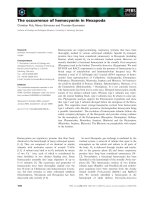
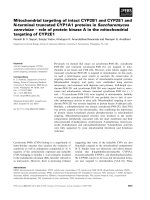
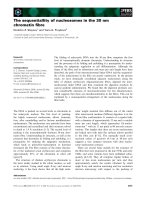
![Tài liệu Báo cáo khoa học: The stereochemistry of benzo[a]pyrene-2¢-deoxyguanosine adducts affects DNA methylation by SssI and HhaI DNA methyltransferases pptx](https://media.store123doc.com/images/document/14/br/gc/medium_Y97X8XlBli.jpg)
